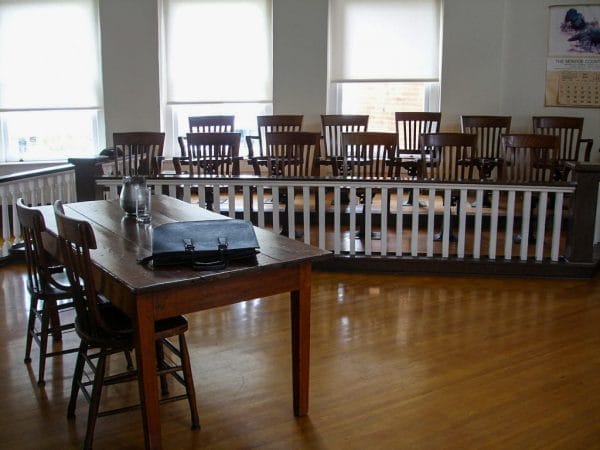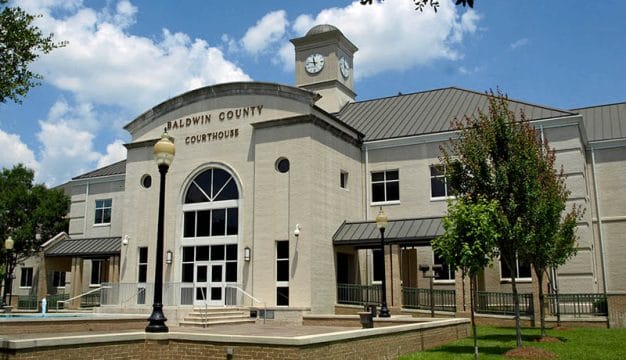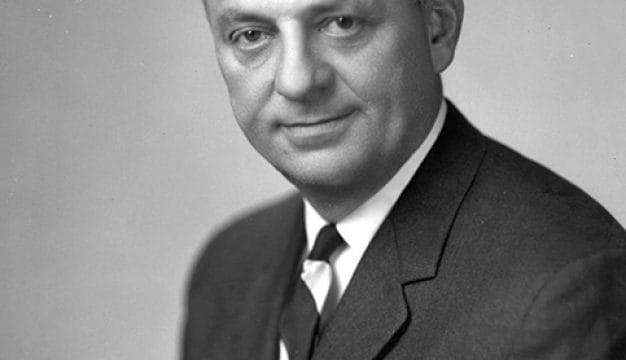Old Monroe County Courthouse Museum
The Old Monroe County Courthouse Museum in Monroeville, Monroe County, is the centerpiece of a five-site group referred to collectively as the Monroe County Heritage Museum. The courthouse’s most significant claim to fame is its inspiration for the fictional courthouse in Harper Lee’s novel To Kill a Mockingbird. In addition to housing four permanent exhibits and serving as the model for the courtroom featured in the film version of Lee’s novel, the courtroom is the setting for the second act of a popular stage production of the novel that is performed annually in April and May in Monroeville. For its connections to Truman Capote and Harper Lee, the museum is a stop on the Southern Literary Trail.
 Old Monroe County Courthouse
The courthouse was constructed in 1903, at the urging of then-probate judge Nicholas J. Stallworth. Although the cost of the building nearly bankrupted the county, the structure was finished and in use in 1904. It was designed by architect Andrew J. Bryan, who designed a number of courthouses throughout the South, and built by contractors M. T. Lewman and Company of Louisville, Kentucky. An identical courthouse constructed in LaGrange, Georgia, later burned. The building gained notoriety in 1960 with the publication of To Kill a Mockingbird and in 1962 with the premier of the film based on the novel. None of the film was shot in the courthouse, but the film set constructed for the courtroom scenes was patterned after the building’s unique oval courtroom.
Old Monroe County Courthouse
The courthouse was constructed in 1903, at the urging of then-probate judge Nicholas J. Stallworth. Although the cost of the building nearly bankrupted the county, the structure was finished and in use in 1904. It was designed by architect Andrew J. Bryan, who designed a number of courthouses throughout the South, and built by contractors M. T. Lewman and Company of Louisville, Kentucky. An identical courthouse constructed in LaGrange, Georgia, later burned. The building gained notoriety in 1960 with the publication of To Kill a Mockingbird and in 1962 with the premier of the film based on the novel. None of the film was shot in the courthouse, but the film set constructed for the courtroom scenes was patterned after the building’s unique oval courtroom.
The courthouse was in use until 1963, when a newer building was constructed in the same town square. A small museum was opened with limited hours in 1968. Large numbers of townspeople called for the building to be razed to make room for downtown parking in the 1970s; however, with the guidance of probate judge Otha Lee Biggs, a small group of people secretly put the building on the National Register of Historic Places, preserving it for posterity. In 1989, a Blue Ribbon Committee was formed to raise funds for restoration, with private donors contributing more than $2.5 million for work done on the building between 1991 and 2002. Periodic restoration work continues on the building today.
The four permanent exhibits in the museum include one on Harper Lee herself and one on her childhood friend and fellow author, Truman Capote. In addition to the annual production of To Kill a Mockingbird, the museum presents a number of events and educational programs centered on the novel and on the history of Monroe County, as well as related to Truman Capote.
 Old Monroe County Courthouse
The Monroe County Heritage Museum (MCHM) has an annual operating budget of $250,000 and five full-time and two part-time employees. An overwhelming majority of work is done by a pool of more than 100 volunteers who contribute several hours a week toward the museum’s functions. Funding comes from a variety of foundations and trusts, and both the city of Monroeville and the Monroe County governments contribute annually toward the operating budget. MCHM was formed in 1991 as a 501(c)(3) and is governed by a board of 15 Monroe County residents from various districts; daily operations are overseen by an executive director. Approximately 20,000 visitors a year tour the famous courthouse and Monroeville, in search of the inspirations for Harper Lee’s fictional town of Maycomb.
Old Monroe County Courthouse
The Monroe County Heritage Museum (MCHM) has an annual operating budget of $250,000 and five full-time and two part-time employees. An overwhelming majority of work is done by a pool of more than 100 volunteers who contribute several hours a week toward the museum’s functions. Funding comes from a variety of foundations and trusts, and both the city of Monroeville and the Monroe County governments contribute annually toward the operating budget. MCHM was formed in 1991 as a 501(c)(3) and is governed by a board of 15 Monroe County residents from various districts; daily operations are overseen by an executive director. Approximately 20,000 visitors a year tour the famous courthouse and Monroeville, in search of the inspirations for Harper Lee’s fictional town of Maycomb.
The other sites that make up the Monroe County Heritage Museums are Rikard’s Mill Historical Park, the Alabama River Museum, the Hybart House Museum and Cultural Center, and the Old Bethany Baptist Church.
Additional Resources
Hughes, Delos D. “Andrew J. Bryan: A New South Architect.” Legacy: The Magazine of the Monroe County Heritage Museum (Spring/Summer 2002): 9-13.
———. “The Lewmans of Louisville: Contractors of the Old Courthouse.” Legacy: The Magazine of the Monroe County Heritage Museum (Spring/Summer 2002): 5-8
Swift, Harriet. “1903 Courthouse Embodies Public Spirit of Judge Nicholas J. Stallworth.” Legacy: The Magazine of the Monroe County Heritage Museum (Spring/Summer 2002): 1-4.



